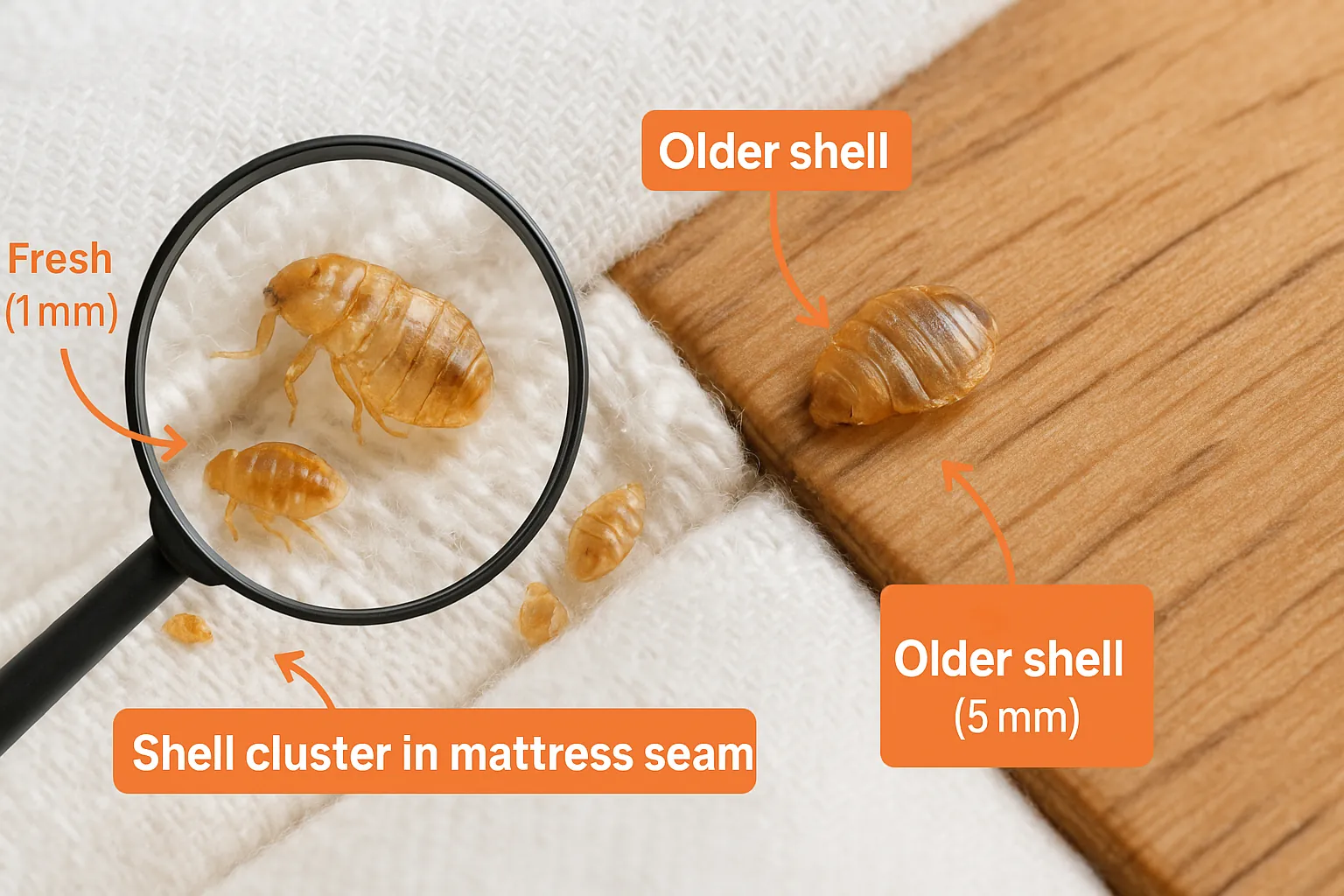
Bed Bug Shells: Complete Visual Identification Guide + Free Photo Analysis

Discovered suspicious evidence and wondering if it’s bed bug shells? You’re right to investigate immediately—bed bug shells are one of the most reliable indicators of an active infestation, and early detection can save you thousands in professional extermination costs.
The smart approach? Modern AI technology now provides instant, expert-level analysis 24/7. Our advanced image recognition system can examine your photo and deliver professional-grade results to your email within moments—no appointment scheduling, no costly inspection fees, no strangers examining your private spaces.
This comprehensive guide shows you exactly what bed bug shells look like on different surfaces, in various stages, and in all common locations. Combined with our complete bed bug identification guide, you’ll have everything needed to confirm your findings and take immediate action.
Ready for instant analysis? Upload your photo for AI analysis
By the end of this guide, you’ll confidently identify bed bug shells and have access to the same treatment methods professionals use—but at a fraction of the cost and with complete privacy.
Table of Contents
- What Bed Bug Shells Actually Look Like
- Bed Bug Shells on Different Surfaces
- Fresh vs. Old Bed Bug Shells
- Bed Bug Shells vs. Other Insect Evidence
- Location Patterns & Discovery Guidelines
- Cleaning & Removal Techniques
- Smart Treatment Options
- Why AI Recognition Beats Guesswork
- Frequently Asked Questions
What Bed Bug Shells Actually Look Like (Visual-heavy section)
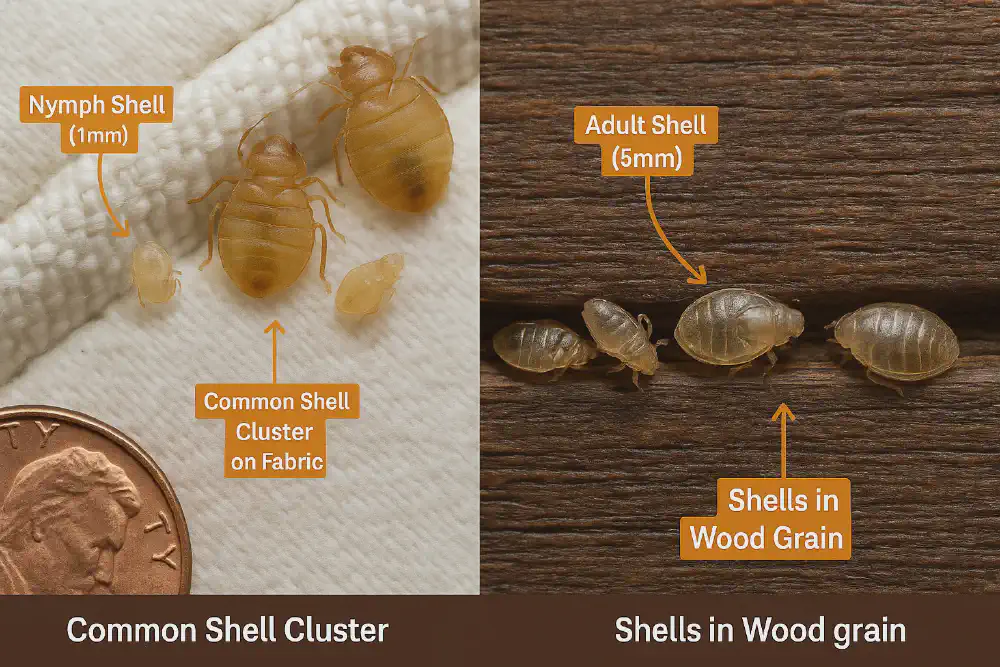
Bed bug shells are the translucent, hollow exoskeletons left behind when bed bugs molt during their growth stages. These shells provide crucial evidence of an active infestation and appear as miniature, empty versions of the actual bugs.
Key Visual Characteristics:
- Color: Light brown to golden-tan, often with a translucent quality
- Size: Range from 1mm (early nymphs) to 5mm (pre-adult stage)
- Shape: Oval and flattened, resembling a deflated bed bug
- Texture: Brittle and papery when dry, with visible segmentation
- Distinctive features: Clearly defined head, thorax, and leg impressions
The shells maintain the bed bug’s characteristic oval shape but lack the plump, blood-filled appearance of live bugs. Under magnification, you can see detailed impressions of antennae, legs, and body segments—like a perfect mold of the insect that once occupied it.
Size Progression: Bed bugs molt five times before reaching adulthood, so you’ll often find shells of varying sizes in the same location, indicating multiple growth stages occurring in that area.
Those translucent shells prove bed bugs are actively molting and growing in your space right now. Every day you wait, more shells appear as the population explodes.
Bed Bug Shells on Different Surfaces (Location targeting)
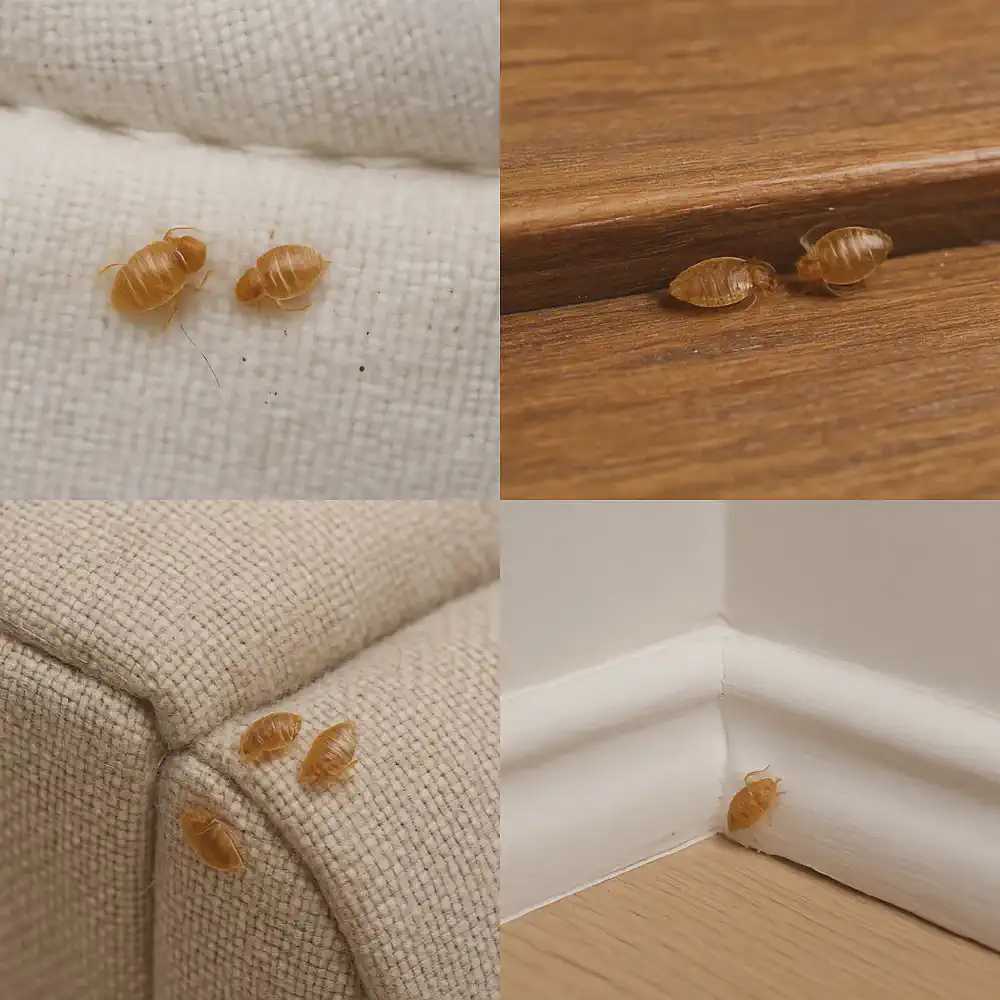
Mattress Seams and Fabric
On mattresses and bedding, bed bug shells often appear caught in seams, folds, or fabric weave. The shells may be partially embedded in the fabric texture, making them appear darker or more defined. Look for clusters of multiple shells along mattress edges, particularly near the head of the bed.
Visual Cues: Shells on fabric often have a crumpled appearance and may be mixed with dark fecal spots or bloodstains, creating a telltale pattern of infestation evidence.
Wood Furniture Surfaces
On wood surfaces like bed frames, nightstands, or baseboards, bed bug shells appear more prominent and easier to spot. The contrast between the light-colored shells and darker wood makes identification clearer. Shells often accumulate in cracks, joints, and recessed areas of furniture.
Surface Patterns: Wood grain can trap shells, causing them to appear in linear patterns following the wood’s natural lines.
Upholstered Furniture
In upholstered chairs, sofas, and cushions, shells become embedded in fabric fibers and may be discovered when moving or cleaning furniture. The shells often cluster in seams, button tufts, and areas where fabric meets the frame.
Hiding Characteristics: Shells in upholstery are often accompanied by live bugs and may be more challenging to spot due to fabric patterns and colors.
Wall and Baseboards
Along walls and baseboards, shells accumulate in cracks, behind picture frames, and in corners where walls meet floors. These locations often show the highest concentration of shells as bed bugs use these areas as highways between feeding and hiding locations.
Pattern Recognition: Wall-based shells often form trails or clusters indicating bed bug travel routes and harborage areas.
Multiple surfaces with shells means they’re spreading through your home - mattress to furniture to walls. This pattern screams established infestation.
Fresh vs. Old Bed Bug Shells (Timeline analysis)

Recently Molted Shells (0-2 weeks)
Fresh bed bug shells appear more translucent and retain some flexibility. They may have a slight sheen and are less likely to be crumbled or damaged. The color is typically lighter—ranging from pale yellow to light brown.
Immediate Indicators: Fresh shells suggest very recent bed bug activity, indicating active feeding and growth cycles. Finding fresh shells means live bugs are definitely present and actively developing.
Aged Shells (2-8 weeks)
Older shells become increasingly brittle and may show signs of darkening around the edges. They’re more likely to be found in fragments rather than intact pieces. The translucent quality diminishes, and they may appear more opaque.
Color Changes: Aged shells develop a darker, more amber coloration and may show environmental staining from dust or other debris.
Very Old Shells (2+ months)
Ancient shells are typically fragmentary, darkened, and may be mixed with dust and debris. They often crumble when disturbed and may be difficult to identify without close examination.
Degradation Patterns: Very old shells may only be identifiable by their characteristic oval shape fragments and the presence of leg or antenna impressions in the debris.
Fresh, translucent shells mean they molted recently - possibly last night while you slept. The timeline is accelerating and you’re running out of time.
Bed Bug Shells vs. Other Insect Evidence (Confusion resolution)
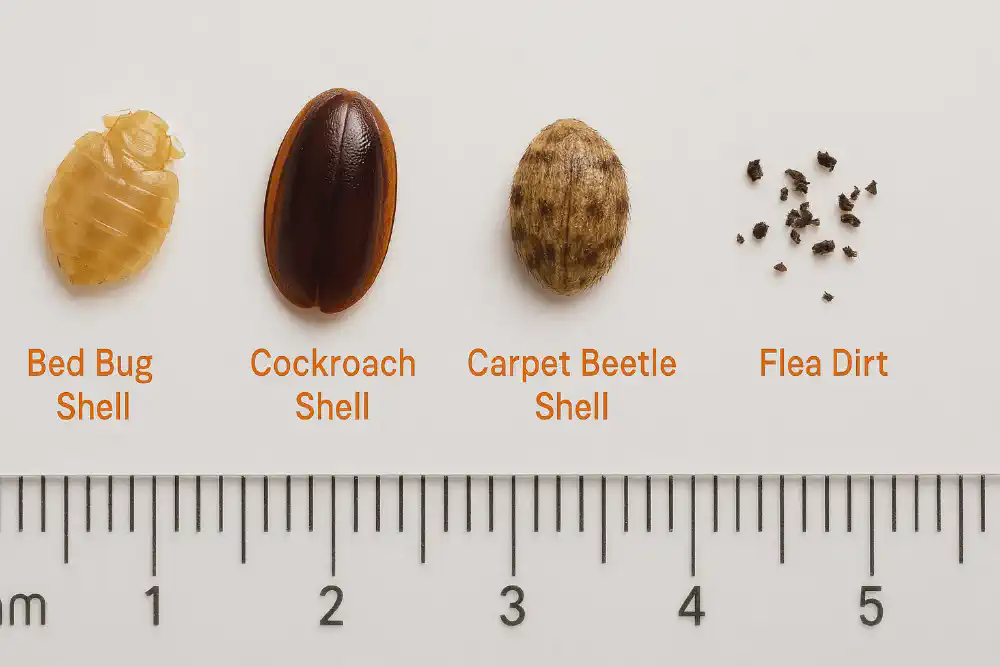
Understanding the differences between bed bug shells and other common household pest evidence prevents misidentification and ensures appropriate treatment responses.
| Evidence Type | Bed Bug Shells | Cockroach Shells | Carpet Beetle Shells | Flea Debris |
|---|---|---|---|---|
| Size | 1–5mm oval | 10–40mm elongated | 2–4mm round | <1mm fragments |
| Color | Light brown/tan | Dark brown/black | Light brown/spotted | Dark brown/black |
| Shape | Oval, flattened | Elongated, curved | Round, dome-shaped | Irregular fragments |
| Texture | Papery, segmented | Hard, glossy | Fuzzy, hair-like | Powdery, scattered |
| Location | Beds, furniture seams | Kitchen, bathroom areas | Carpets, stored clothing | Pet areas, carpets |
Distinguishing from Ant Casings
Unlike bed bugs vs ants differences, bed bug shells are significantly larger and show clear segmentation. Ant casings are typically smaller, more elongated, and found in different locations (usually near food sources or entry points).
Comparison with Carpet Beetle Evidence
Carpet beetle shells are rounder and often covered with small hairs or bristles. They’re typically found in stored clothing, carpets, or areas with natural fibers—not concentrated around sleeping areas like bed bug shells.
Differentiating from Booklice or Psocid Shells
Booklice shells are much smaller (under 2mm) and found in humid areas like bathrooms or basements. They lack the distinctive oval shape and segmentation of bed bug shells.
Mistaking shells for lint or debris costs weeks of infestation growth. While you’re guessing, they’re multiplying exponentially in your bedroom.
Location Patterns & Discovery Guidelines (Evidence hunting)
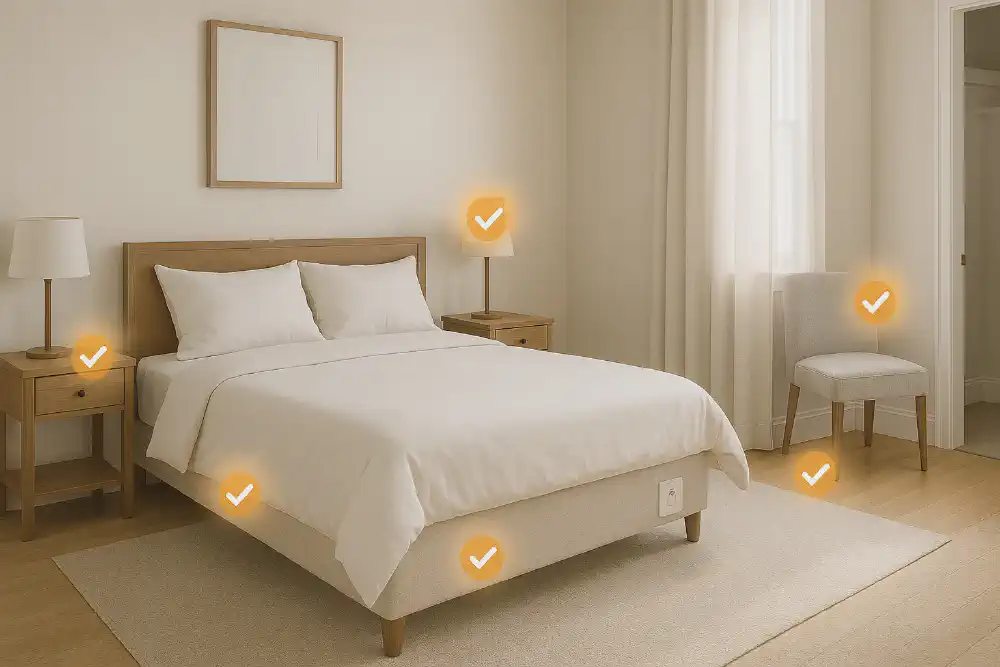
Most Common Bed Bug Shell Locations
Primary Discovery Areas (90% of finds):
- Mattress seams and box spring corners
- Bed frame joints and headboard crevices
- Nightstand drawers and behind furniture
- Baseboards within 8 feet of beds
- Upholstered furniture seams and cushions
Secondary Discovery Areas (60% of infestations):
- Behind picture frames and wall hangings
- Electrical outlet covers near beds
- Curtain hems and window treatments
- Closet areas and stored clothing
- Carpet edges and under furniture
Advanced Infestation Areas (30% of severe cases):
- Doorframes and window sills
- Books and paper storage areas
- Electronic device casings
- Wall cracks and ceiling junctions
- Behind wallpaper and loose paint
Infestation Severity Indicators by Shell Quantity
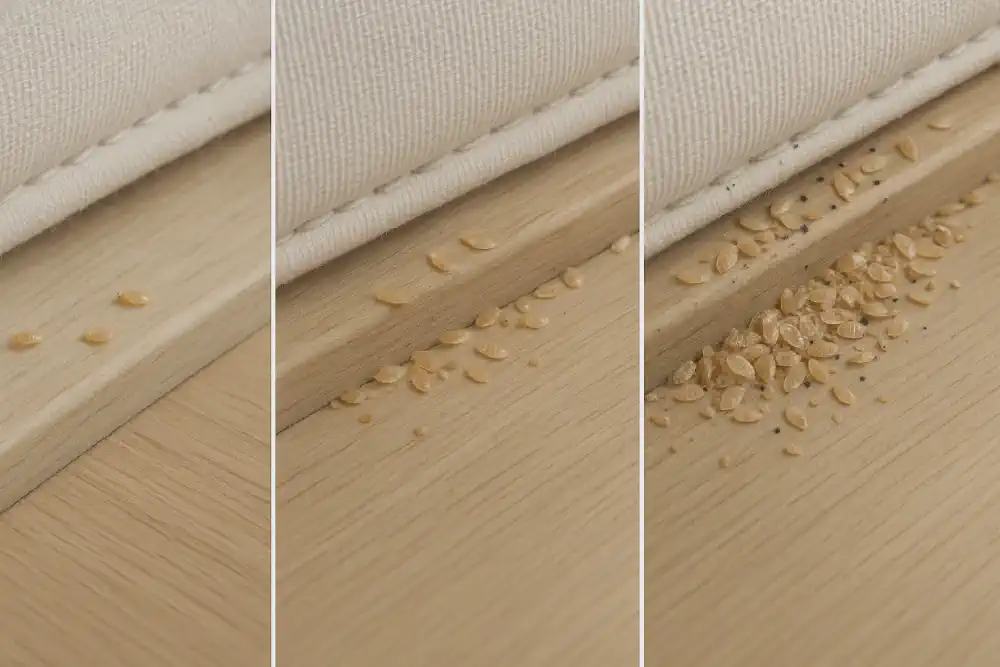
Light Infestation (1-10 shells found):
- Recently introduced bed bugs
- Small population, likely confined to one area
- Treatment success rate: 95% with proper approach
Moderate Infestation (11-50 shells found):
- Established population, multiple growth cycles
- Spread to 2-3 rooms or furniture pieces
- Treatment success rate: 85% with comprehensive approach
Heavy Infestation (50+ shells found):
- Long-established population with multiple generations
- Widespread distribution throughout living space
- Treatment success rate: 75% requiring intensive, professional-grade methods
Systematic Inspection Process
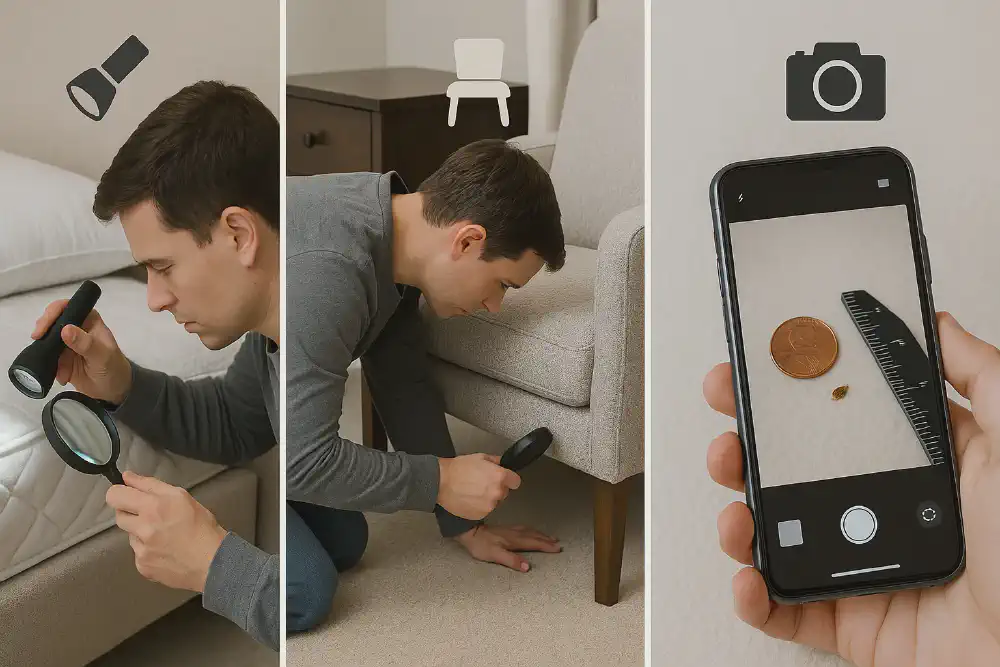
Step 1: Primary Zone Inspection (Sleeping Areas) Using a flashlight and magnifying glass, examine all bed-related surfaces systematically. Focus on seams, cracks, and junction points where shells typically accumulate.
Step 2: Secondary Zone Inspection (Adjacent Furniture) Expand search to furniture within 8 feet of beds. Pay special attention to areas where baby bed bugs might hide during early development stages.
Step 3: Documentation Photography Photograph all discovered shells with size references (coins, rulers) for professional analysis and treatment planning.
The pattern of shell distribution tells the story of your infestation—get professional detective analysis to decode exactly what you’re dealing with.
Cleaning & Removal Techniques (Practical solutions)
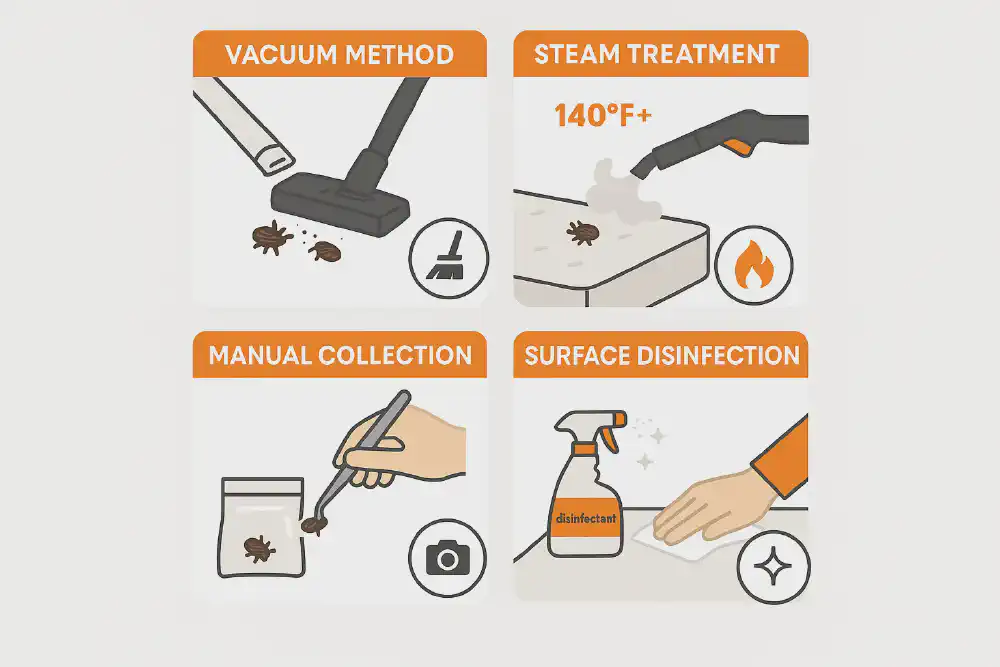
Immediate Shell Removal Steps
Safety First: Wear gloves and a dust mask when handling bed bug shells to prevent skin irritation and inhalation of shell fragments.
Vacuum Collection Method:
- Use a vacuum with strong suction and a crevice attachment
- Vacuum all visible shells and surrounding areas thoroughly
- Immediately seal vacuum bag in plastic and dispose externally
- Clean vacuum canister with hot, soapy water if bagless
Manual Collection for Analysis:
- Use tweezers to collect intact shells for professional identification
- Place specimens in clear containers or plastic bags
- Label with location and date of discovery
- Photograph before and after collection
Surface-Specific Removal Methods
Fabric Surfaces (Mattresses, Upholstery):
- Steam treatment at 140°F+ penetrates fabric fibers
- Hot water extraction removes embedded shells and debris
- Vacuum thoroughly after steam treatment
- Consider professional cleaning for valuable furniture pieces
Hard Surfaces (Wood, Metal, Plastic):
- Disinfectant wipes remove shells and sanitize surfaces
- Scrub brushes reach into cracks and crevices
- Steam cleaning for sanitization without chemicals
- Sealants can prevent future shell accumulation in cracks
Delicate Areas (Electronics, Books, Papers):
- Compressed air blows shells from sensitive areas
- Soft brushes remove shells without damage
- Freezing treatment (0°F for 4 days) kills any remaining bugs
- Professional electronic cleaning for valuable equipment
Product Recommendations
Professional-Grade Vacuum Cleaners:
- HEPA filtration captures microscopic shell particles
- Strong suction removes embedded shells from fabric
- Sealed systems prevent re-contamination during disposal
Steam Cleaning Equipment:
- Dry steam (low moisture) prevents damage to electronics
- High-temperature capability (180°F+) ensures thorough sanitization
- Variable pressure settings for different surface types
Sanitization Products:
- Enzyme-based cleaners break down organic shell material
- Isopropyl alcohol (70%+) disinfects and removes shell residue
- Microfiber cloths trap shell fragments effectively
Prevention of Shell Accumulation
Protective Barriers:
- Mattress encasements trap shells and prevent new infestations
- Furniture leg traps capture shells during bed bug movement
- Diatomaceous earth creates barriers that damage shell integrity
Environmental Modifications:
- Reduce humidity (below 50%) makes shells more brittle and visible
- Increase lighting in hiding areas makes shells easier to spot
- Regular furniture repositioning prevents long-term accumulation
Professional cleaning methods eliminate shells completely while preventing re-infestation—get FREE guidance on the most effective approach for your situation.
Smart Treatment Options (AI-powered solution positioning)
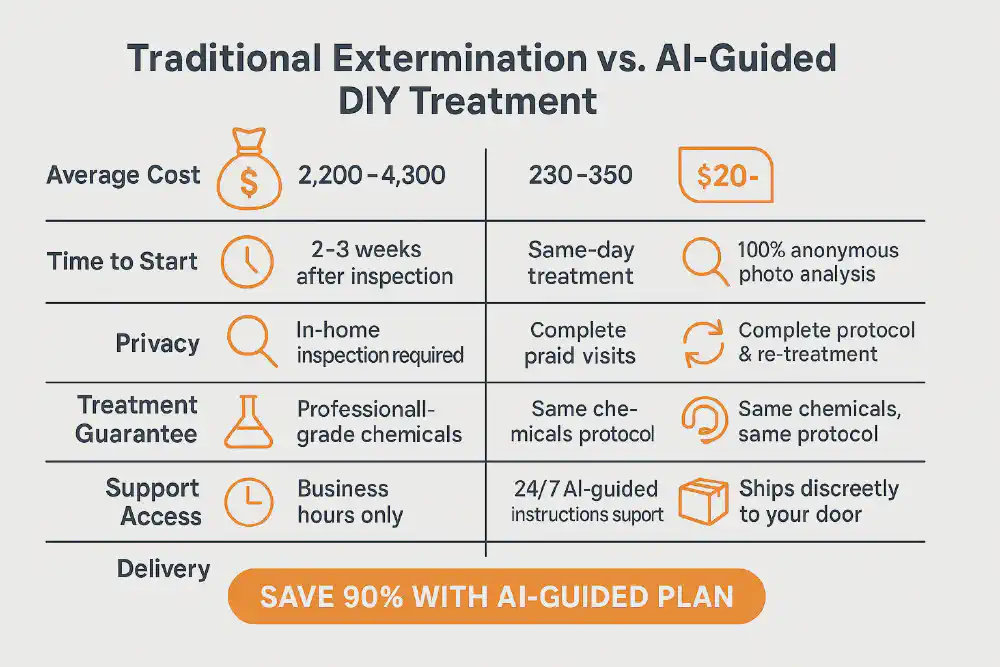
Traditional vs. AI-Guided DIY Comparison
Traditional Professional Extermination:
- Cost: $2,000-$5,000 for average home treatment
- Timeline: 2-4 weeks from initial inspection to treatment completion
- Privacy: Strangers examining your private spaces and belongings
- Guarantee: Often requires multiple treatments with additional costs
- Availability: Appointment-dependent, often 1-2 week wait times
AI-Guided DIY Treatment:
- Cost: $200-$400 for complete treatment kit with professional guidance
- Timeline: Instant analysis, treatment begins within 24 hours
- Privacy: Complete confidentiality, no home inspections required
- Guarantee: Same professional-grade methods with personalized guidance
- Availability: 24/7 instant access with immediate results
Cost Analysis: Professional vs. Smart DIY
Professional Treatment Breakdown:
- Initial inspection: $200-$300
- Chemical treatment: $1,500-$3,000
- Follow-up treatments: $300-$500 each
- Preparation costs: $200-$500 (cleaning, laundry, temporary housing)
- Total Average Cost: $2,200-$4,300
AI-Guided DIY Treatment Breakdown:
- AI analysis and treatment plan: FREE
- Professional-grade treatment kit: $180-$250
- Additional supplies (encasements, monitoring): $50-$100
- Total Average Cost: $230-$350
Savings: $1,970-$3,950 (85-90% cost reduction)
Treatment Effectiveness Comparison
Both professional and AI-guided DIY treatments use identical active ingredients and application methods. The difference lies in the delivery system and ongoing support:
Professional Methods We Replicate:
- Integrated Pest Management (IPM) approach
- Targeted application of EPA-approved insecticides
- Heat treatment protocols for immediate kill
- Monitoring and follow-up assessment
- Prevention and exclusion techniques
AI Advantages:
- Personalized treatment sizing based on exact infestation parameters
- Real-time adjustment of treatment protocols based on progress photos
- 24/7 support for questions and concerns during treatment
- Cost-effective re-treatment options if needed
- Complete documentation of treatment progress
Speed Comparison: Instant AI vs. Appointment Scheduling
Traditional Professional Timeline:
- Day 1: Discover evidence, research companies
- Day 3-10: Schedule inspection (average wait time)
- Day 10: Professional inspection and quote
- Day 17-24: Treatment appointment availability
- Day 24+: Treatment begins
AI-Guided Timeline:
- Hour 1: Upload photo, receive analysis
- Hour 2: Review treatment plan, order supplies
- Day 2: Receive treatment kit, begin application
- Day 3-7: Monitor progress with AI guidance
- Day 7: Follow-up analysis and adjustment if needed
Time Savings: 2-3 weeks faster treatment start
Privacy Advantages of Self-Treatment
Professional Inspection Privacy Concerns:
- Strangers examining bedroom areas and personal belongings
- Detailed documentation of living conditions
- Potential judgment about cleanliness or lifestyle
- Required preparation and cleaning before visits
- Neighbors and visitors aware of pest control presence
AI-Guided Privacy Benefits:
- Complete anonymity—no personal information shared
- No strangers in your home or bedroom
- Confidential photo analysis with secure processing
- Private treatment application on your schedule
- Discreet delivery and treatment without external awareness
Why pay thousands for the same treatment methods when AI guidance delivers identical results at 90% lower cost? Get your FREE professional analysis now.
Why FREE Professional Detective Service Beats Guesswork
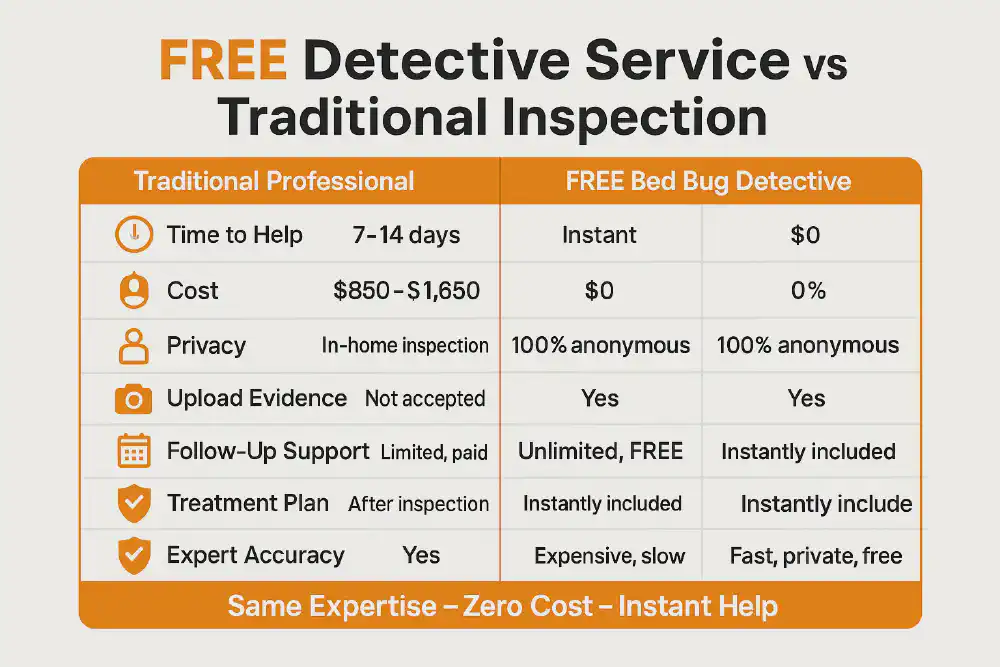
Expert Bed Bug Identification Available 24/7
Finding bed bug shells is strong evidence of an infestation, but confirming live bed bugs is crucial for effective treatment. Our FREE bed bug detective service connects you with professional guidance instantly—no appointment scheduling, no inspection fees, no waiting.
How Our FREE Detective Service Works:
- Upload your photos: Share images of suspected bed bugs or evidence
- Expert analysis: Professional bed bug identification and guidance
- Instant consultation: Get immediate answers about what you’re dealing with
- Treatment guidance: Personalized recommendations based on your specific situation
- Complete privacy: No strangers in your home, no costly inspections
Eliminates Costly Professional Inspection Fees
Traditional Professional Inspection Costs:
- Initial inspection fee: $200-$300
- Follow-up inspection: $150-$250
- Misidentification costs: $200-$500 wasted on wrong treatments
- Multiple inspection fees: $300-$600 for repeated visits
- Total potential cost: $850-$1,650
Our FREE Detective Service:
- Professional consultation: FREE
- Expert identification: FREE
- Treatment guidance: FREE
- Unlimited questions: FREE
- Total cost: $0
Same Professional Expertise, No Cost
Professional pest control companies charge hundreds for the same identification and consultation services we provide for free:
What Professionals Charge For:
- Visual bed bug identification and confirmation
- Infestation severity assessment
- Treatment recommendations and guidance
- Species verification to rule out look-alike insects
- Follow-up consultation and support
What We Provide FREE:
- Expert bed bug identification through photo analysis
- Professional consultation on your specific situation
- Personalized treatment recommendations
- Unlimited follow-up questions and guidance
- Complete privacy without home inspections
Instant Expert Help vs. Waiting for Appointments
Traditional Professional Inspection:
- Average wait time for appointment: 7-14 days
- Inspection duration: 60-90 minutes in your home
- Report delivery: 24-48 hours after inspection
- Treatment quote: Additional time for estimate
- Total time to treatment plan: 10-17 days
Our FREE Detective Service:
- Photo upload and consultation: Available instantly
- Expert analysis and guidance: Immediate response
- Treatment recommendations: Provided immediately
- Professional kit ordering: 24-48 hours shipping
- Total time to treatment start: 1-2 days
Speed Advantage: 8-15 days faster than traditional professional inspection
Complete Treatment Automation
Unlike expensive professional services that require multiple appointments, our FREE detective service provides complete guidance for effective DIY treatment using the same professional-grade methods:
Automated Support Features:
- Professional-grade treatment kits: Same products professionals use
- Step-by-step guidance: Detailed instructions for effective application
- Progress monitoring: Ongoing support throughout treatment
- Success tracking: Confirmation of treatment effectiveness
- Unlimited consultation: Continuous expert support at no cost
Complete Treatment Automation
Unlike traditional pest control that requires multiple appointments and ongoing professional intervention, our AI system automates the entire treatment process:
Automated Treatment Features:
- Pre-filled shopping carts: Exact quantities of professional-grade supplies
- Step-by-step email guidance: Daily treatment instructions delivered automatically
- Progress tracking: Photo-based monitoring with AI-powered progress assessment
- Automatic adjustments: Treatment plan modifications based on progress photos
- Success confirmation: AI-verified treatment completion analysis
Professional Convenience Without Professional Costs:
- No scheduling conflicts or missed appointments
- No preparation requirements for professional visits
- No follow-up appointment coordination
- No additional fees for plan modifications or questions
- No contract obligations or long-term service agreements
Get the same professional analysis that pest controllers use—but instantly, privately, and completely FREE. Upload your shell photos now for immediate expert identification.
FREE Professional Analysis
Get the same analysis pest controllers charge hundreds for—completely FREE.
Frequently Asked Questions
What do bed bug shells look like and how can I identify them?
Bed bug shells are translucent, light brown to golden-tan colored exoskeletons that are oval and flattened, ranging from 1-5mm in length. They appear as hollow, empty versions of bed bugs with visible segmentation and leg impressions, often found in mattress seams, furniture cracks, and baseboards.
How many bed bug shells indicate a serious infestation?
Finding 1-10 shells suggests a light infestation, 11-50 shells indicates moderate infestation, and 50+ shells means heavy infestation. The distribution pattern and age of shells also matters—fresh shells in multiple locations suggest active, spreading populations requiring immediate treatment.
Where are bed bug shells most commonly found in homes?
Bed bug shells are most commonly found in mattress seams (90% of cases), bed frame joints, nightstand crevices, baseboards within 8 feet of beds, and upholstered furniture seams. Secondary locations include behind picture frames, curtain hems, and closet areas.
Can I remove bed bug shells myself or do I need professional help?
You can safely remove bed bug shells yourself using vacuum extraction and proper disposal methods. However, shells indicate live bed bugs are present, so you'll need effective treatment. Professional inspection costs $200-300, but AI analysis provides the same identification for free.
How do I tell the difference between bed bug shells and other insect casings?
Bed bug shells are 1-5mm oval shapes with clear segmentation, while cockroach shells are larger and elongated, carpet beetle shells are round and fuzzy, and ant casings are smaller and more elongated. Location is key—bed bug shells cluster around sleeping areas.
Are fresh bed bug shells more dangerous than old ones?
Fresh shells (0-2 weeks old) are more concerning because they indicate very recent bed bug activity and active feeding cycles. Old shells show historical infestation but fresh ones mean live bugs are currently present and actively reproducing, requiring immediate treatment.
What should I do immediately after finding bed bug shells?
Photograph the shells with size reference, vacuum carefully and dispose of contents in sealed bags, inspect for additional evidence like live bugs or blood spots, and get professional identification analysis. Don't disturb the area until you have a complete treatment plan.
How long do bed bug shells last before they decompose?
Bed bug shells can remain intact for 2-6 months depending on environmental conditions. Fresh shells are translucent and flexible, aging shells become darker and more brittle, and very old shells (2+ months) fragment into pieces mixed with dust and debris.
Can bed bug shells cause allergic reactions or health problems?
Bed bug shells themselves can trigger allergic reactions in sensitive individuals, potentially causing skin irritation, respiratory symptoms, or asthma flare-ups. The shell material contains proteins that some people react to, making proper removal and sanitization important for health.
Do bed bug shells always mean there's an active infestation?
Yes, bed bug shells are molted exoskeletons from growing bed bugs, so their presence always indicates bed bugs have been feeding and developing in that location. While very old shells might indicate past infestation, fresh shells definitely mean active, current bed bug populations.
What's the most effective way to clean up bed bug shells?
Use a vacuum with strong suction and HEPA filtration to collect shells, immediately seal and dispose of vacuum contents, steam clean fabric surfaces at 140°F+, wipe hard surfaces with disinfectant, and consider professional cleaning for valuable items. Always wear gloves and masks during cleanup.
How do professionals identify bed bug shells versus DIY identification?
Professionals use magnification tools, species identification guides, and experience with shell patterns and locations. However, AI recognition systems now provide the same analytical capabilities 24/7 at no cost, offering professional-grade identification without appointment scheduling or inspection fees.
Can I prevent bed bug shells from accumulating in my home?
Prevent bed bug shells by using mattress encasements, regular inspection of sleeping areas, reducing clutter that provides hiding places, maintaining low humidity levels, and addressing any bed bug evidence immediately before populations can establish and begin molting cycles.
What do different sized bed bug shells tell me about the infestation?
Multiple shell sizes indicate various growth stages: 1mm shells from first nymph stage, 2-3mm from intermediate stages, and 4-5mm from final nymph stage before adulthood. Finding all sizes suggests established populations with complete breeding cycles occurring in your home.
Are bed bug shells easier to find than live bed bugs?
Yes, bed bug shells are often easier to spot than live bugs because they don't hide actively and accumulate in feeding/molting areas over time. Live bed bugs hide during daylight hours, but shells remain visible as evidence of their presence and activity patterns.
Ready to Take Action?
Bed bug shells are definitive proof of an active infestation that requires immediate attention. While finding these translucent, oval-shaped exoskeletons can be alarming, you now have the knowledge to identify them accurately and understand exactly what they mean for your situation.
The smart approach is getting professional-grade analysis without professional-grade costs. Our AI-powered image recognition system provides the same identification expertise that pest control companies use—but instantly, privately, and completely free.
Why spend weeks waiting for expensive professional inspections when you can get expert analysis in minutes? Upload your photos now and receive immediate, professional-grade identification results that would typically cost $200-300 from traditional pest control companies.
Every shell you found represents a bed bug that’s now larger, hungrier, and ready to reproduce. The window for easy treatment is closing fast.
Window Closing Fast
FREE bed bug detective service—get expert help before it's too late.
Worried About Bed Bugs? Find Out Now – For Free!
Upload a picture and get instant, free detection. No guessing—just fast, accurate results. If bed bugs are found, we’ll recommend the right products and simple step-by-step treatment.
Click here to start – it’s 100% free!
Get started nowWorried About Bed Bugs? Find Out Now – For Free!
Upload a picture and get instant, free detection. No guessing—just fast, accurate results. If bed bugs are found, we’ll recommend the right products and simple step-by-step treatment.
Click here to start – it’s 100% free!
Get started now